- LAGRANGIAN
- Posts
- Issue 73 | Breaking Space News: Oct 19 - 25, 2025
Issue 73 | Breaking Space News: Oct 19 - 25, 2025
In Militarization of Space, Apex, a US Defense Contractor, Wants to Demonstrate Storage and Deployment of Missiles in Orbit. This Week in Space News: Beautiful, Haunting Images of Glacier Retreat in Chile, Smoking Space Debris in Australia and the Largest Galaxy Cluster Catalog Yet. Risks of Orbital Mirrors and Sunlight Dimming. Plus: NASA Wants to Rethink SpaceX's Artemis III Contract, Impossible Chemistry on Titan, and More.

Explorer, welcome back!🚀
Thanks for joining again. A well‑rounded week in science with fresh updates in the commercial sector. Don’t forget the publication reads better on the link below. ⬇️⬇️
Let’s dive in
Astronomers Compile Largest Galaxy Cluster Catalog to Probe Dark Universe
Astronomers Warn of Major Risks as Reflect Orbital Seeks FCC Approval for Space Mirror Demonstration
Scientists Warn that Large‑Scale Sunlight Dimming to Curb Climate Change Could Disrupt Weather
Jupiter’s Early Development May Have Prevented Earth from Falling Into the Sun
JAXA’s HTV‑X Spacecraft Begins First Mission Delivering Cargo to the ISS

IMAGES
Shrinking Chilean Glaciers in the Laguna San Rafael National Park : Copernicus Sentinel-2

Satellite images from 1987 and 2024 reveal dramatic retreat of Chile’s San Rafael and San Quintín glaciers, the two largest outlets of the Northern Patagonian Ice Field. Once part of a vast ice sheet, the region now holds the second largest ice mass outside the poles. Over nearly four decades, both glaciers have receded significantly, San Rafael continues to calve into Laguna San Rafael, while San Quintín’s terminus has pulled back to form a new proglacial lake.
In this 2024 image, the changing water color, from deep blue to milky aquamarine, reflects sediment-rich meltwater known as “glacier milk.” These shifts illustrate the accelerating impact of global warming on cryospheric systems. As glaciers melt, they contribute to sea-level rise, one of the most visible consequences of climate change. (Credit: USGS/ESA; contains modified Copernicus Sentinel data (2024), processed by ESA)

In 1987, the San Rafael and San Quintín glaciers in Chile’s Laguna San Rafael National Park extended much farther, with San Quintín nearly reaching land. The ice field fed numerous outlet glaciers, reflecting a more expansive cryospheric footprint. (Credit: USGS/ESA; contains modified Copernicus Sentinel data (2024), processed by ESA)
Mysterious, Smoking Space Debris in Western Australia

A smoldering debris site discovered in the Australian outback is believed to be the remains of a Chinese Long March 3B rocket stage, likely from a launch conducted in August 2022. The wreckage, found by local residents near the town of Green Head, includes scorched metal fragments and a partially intact cylindrical structure. Experts suggest the debris reentered Earth’s atmosphere uncontrolled.
While no injuries were reported, the incident has reignited concerns over the risks posed by untracked reentries and the need for clearer international protocols on space debris mitigation. Australia’s space agency is coordinating with Chinese authorities to confirm the origin and assess any environmental impact. (Credit: Western Australia Police Force)

SCIENCE
Astronomers Compile Largest Galaxy Cluster Catalog to Probe Dark Universe
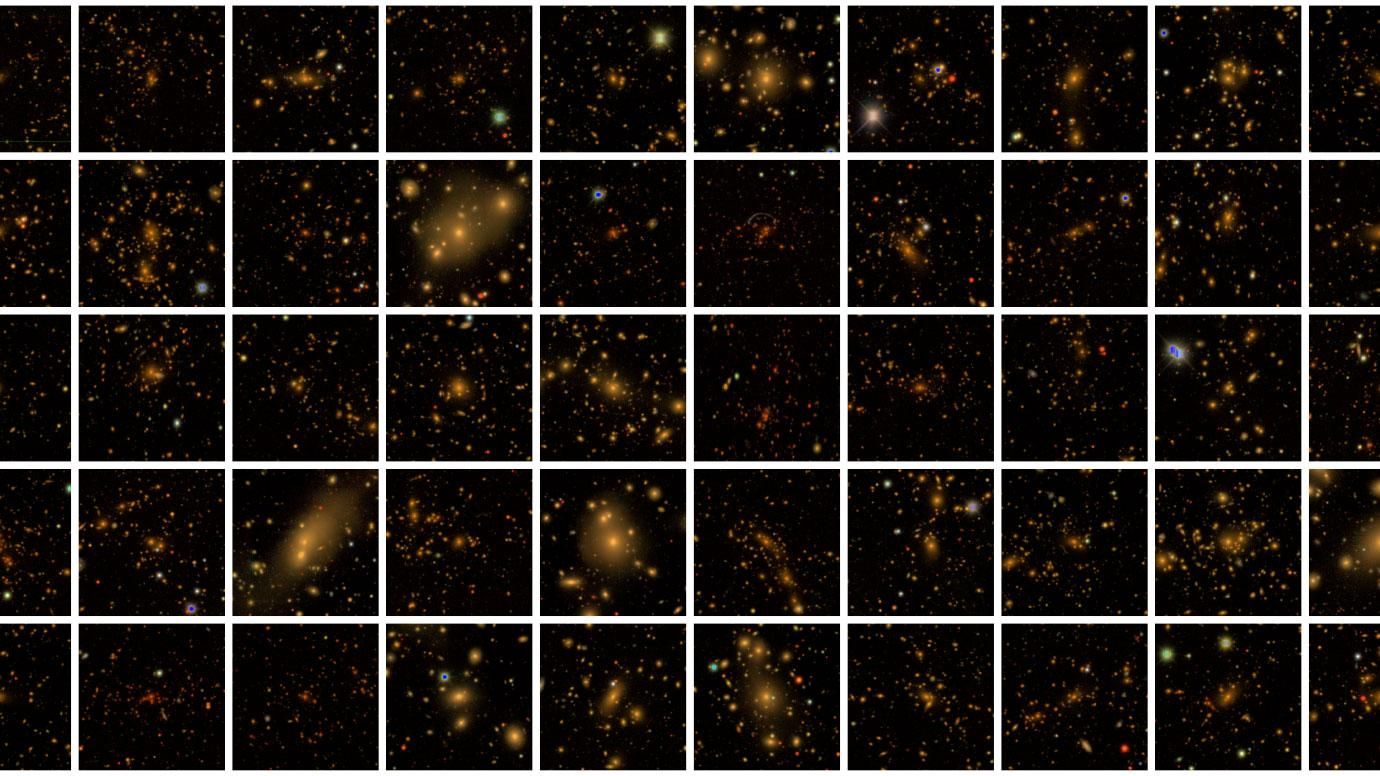
Researchers have mapped massive galaxy clusters, among the largest structures in the cosmos, providing fresh insight into the universe’s origins and governing forces. (Credit: Dark Energy Survey)
21 October, 2025
Astronomers have released the largest catalog to date of galaxy clusters, some of the most massive structures in the universe, using data from the Dark Energy Survey (DES). The six‑year project, led by the University of Chicago and Fermilab, mapped thousands of clusters across the southern sky to test how well current cosmological models describe the universe. Galaxy clusters, bound by dark matter and influenced by dark energy, serve as sensitive probes of cosmic structure.
The new analysis addresses long‑standing debates over the so‑called “S8 tension,” a discrepancy between how clumpy the universe appears today versus predictions from the early cosmos. By carefully accounting for observational biases, researchers found results consistent with the standard Lambda‑CDM model, reinforcing its status as the leading framework for cosmology. The catalog will also provide a foundation for upcoming observatories, such as the Rubin Observatory and NASA’s Roman Space Telescope, which will expand cluster surveys dramatically. The study was published in the journal Physical Review D.
Astronomers Warn of Major Risks as Reflect Orbital Seeks FCC Approval for Space Mirror Demonstration
21 October, 2025
Reflect Orbital, California startup has unveiled plans to deploy 4,000 satellites equipped with giant reflective panels designed to beam sunlight back to Earth, a concept it frames as a potential solution for clean energy generation. Reflect Orbital has applied to the FCC to launch its demonstration satellite, EARENDIL‑1, in April 2026. The spacecraft will deploy a 60‑by‑60‑foot/18‑by‑18‑meter mirror to test redirecting sunlight onto Earth. Backed by a $1.25 million U.S. Air Force SBIR contract, the company ultimately envisions a constellation that could provide “light on demand” to customers after sunset and before sunrise, effectively lengthening usable daylight hours.
Astronomers, however, have raised sharp concerns. Large reflective surfaces in orbit could dramatically increase light pollution, complicating ground‑based observations and threatening the visibility of the night sky. Researchers warn that the mirrors might outshine stars, interfere with sensitive instruments, and add to the growing problem of orbital congestion. Critics also note that the project has not undergone rigorous environmental or regulatory review.
The proposal illustrates a larger issue where private ventures advance ambitious orbital infrastructure concepts faster than governance frameworks can adapt.
Scientists Warn that Large‑Scale Sunlight Dimming to Curb Climate Change Could Disrupt Weather
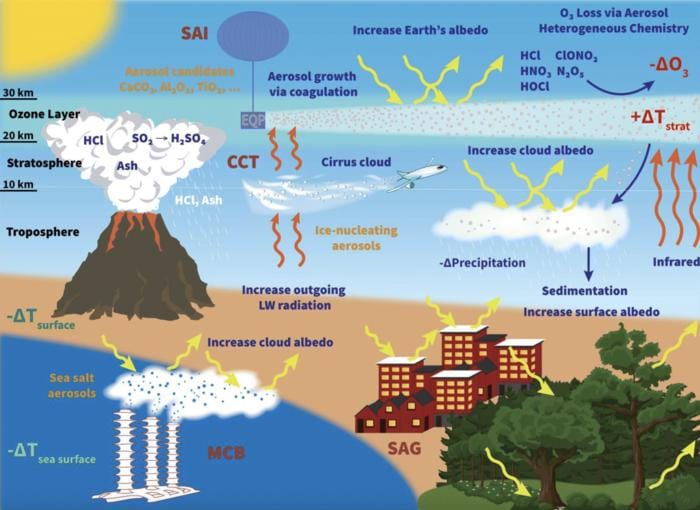
Illustration of proposed climate geoengineering methods, including stratospheric aerosol injection (SAI), cirrus cloud thinning (CCT), and marine cloud brightening (MCB), along with their delivery systems and possible effects. For comparison, natural aerosol release from a volcanic eruption is shown. Surface albedo geoengineering (SAG) is also depicted through examples such as white urban rooftops and modified vegetation. (Credit: Columbia Climate School)
21 October, 2025
New research is casting doubt on the practicality of solar radiation management, a geoengineering approach that seeks to cool the planet by reflecting sunlight back into space. A Columbia University team warns that stratospheric aerosol injection (SAI), which has long been modeled as a potential stopgap against climate change, faces far greater technical, economic, and geopolitical hurdles than simulations suggest. While volcanic eruptions such as Mount Pinatubo in 1991 demonstrated that aerosols can temporarily lower global temperatures, they also disrupted rainfall patterns and depleted ozone.
The study notes that outcomes depend heavily on where and when particles are released, with deployments in polar or equatorial regions potentially altering monsoons or jet streams. Material constraints add further uncertainty: while sulfates are abundant, alternatives like alumina or calcium carbonate present clumping and dispersal challenges. Scientists caution that unilateral or poorly coordinated attempts could destabilize weather systems, making governance as critical as technology. The study was published in the journal Scientific Reports.
Jupiter’s Early Development May Have Prevented Earth from Falling Into the Sun
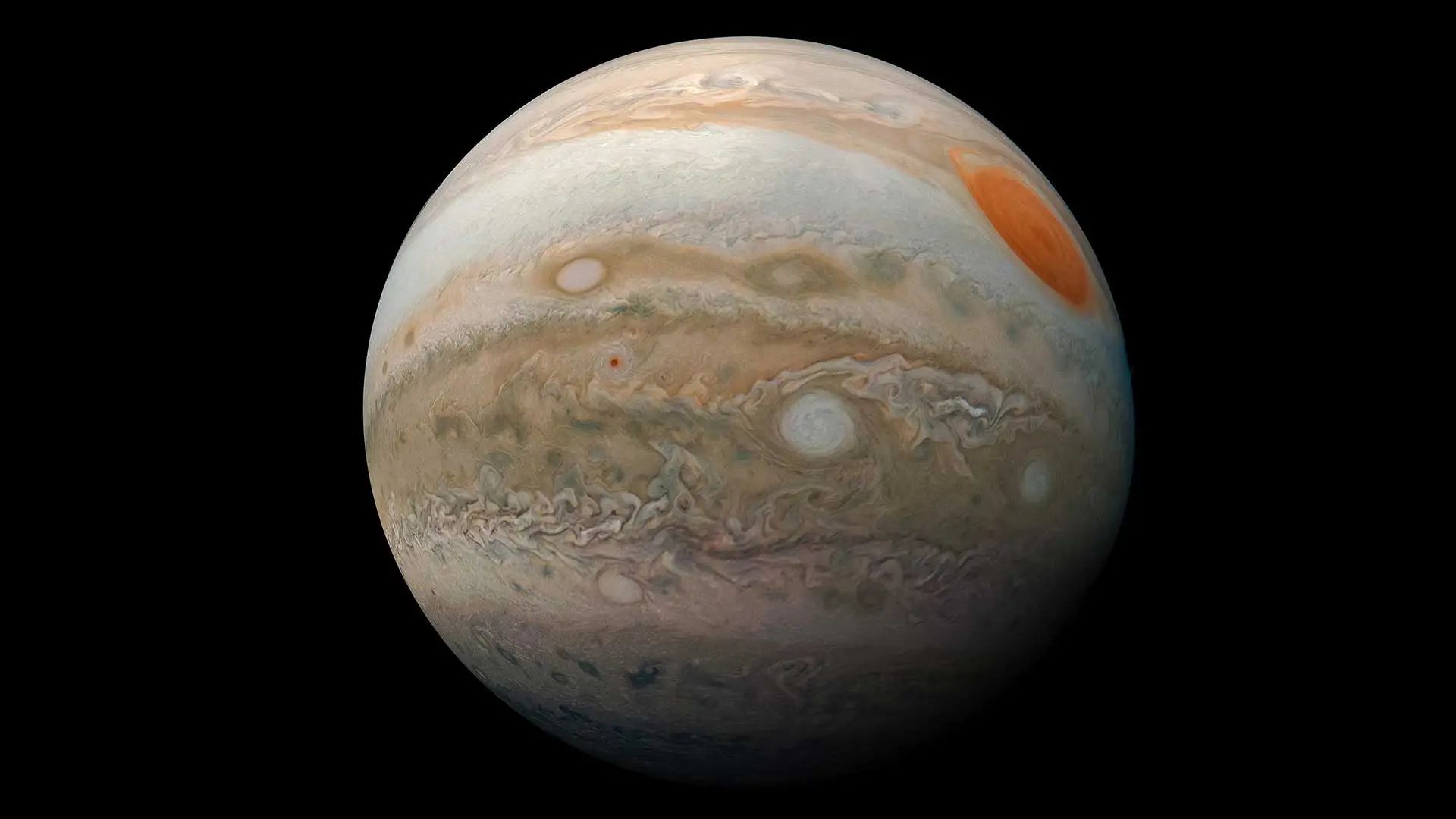
This color‑enhanced view of Jupiter’s Great Red Spot was created from three images captured by NASA’s Juno spacecraft on Feb. 12, 2019, while flying between 16,700 miles (26,900 kilometers) and 59,300 miles (95,400 kilometers) above the planet’s cloud tops. (Credit: Image processing by Kevin M. Gill (CC‑BY) using data from NASA/JPL‑Caltech/SwRI/MSSS)
22 October, 2025
New research led by Rice University scientists suggests Jupiter’s early growth fundamentally shaped the solar system and may have been essential for Earth’s survival. Using computer simulations, the team modeled how the giant planet’s rapid formation carved gaps in the protoplanetary disk of gas and dust surrounding the young Sun. These gravitational “traffic jams” trapped material that would otherwise have spiraled into the star, creating stable zones where rocky planets like Earth, Venus, and Mars could form.

Diagram of Jupiter’s growth. (Credit: Rice University)
The study also helps explain why meteorites preserve two distinct isotopic signatures, one from the inner solar system and another from the outer regions. Jupiter’s presence effectively divided the disk, preventing free mixing of material. The planet’s gravitational influence also delayed the formation, by 2 to 3 million years after the first solids, of certain primitive meteorites, chondrites, offering clues about the timing of early solar system processes. The findings were published in a paper in the journal Science Advances.
JAXA’s HTV‑X Spacecraft Begins First Mission Delivering Cargo to the ISS
25 October, 2025
Japan has launched the HTV‑X, its next‑generation cargo spacecraft, marking a major upgrade from the retired H‑II Transfer Vehicle “Kounotori,” Japanese for White Stork. Developed by JAXA with Mitsubishi Heavy Industries, the HTV‑X is designed to deliver up to six tons/13,200 pounds of pressurized and unpressurized cargo to the International Space Station (ISS). Its streamlined structure and modular racks allow more efficient use of space, while new capabilities include powering experiment payloads during transit and loading cargo as little as 24 hours before launch, an improvement over the 80‑hour requirement of its predecessor. The older H-II flew nine missions to the ISS between September 2009 and May 2020 and is 1.2meter/4 feet longer than the 8 meter/26.2 feet long HTV-X.
Beyond resupply, the HTV‑X is intended as a multipurpose platform. After departing the ISS, it can operate independently for up to 18 months, supporting technology demonstrations and experiments in orbit. JAXA also envisions the vehicle contributing to future exploration initiatives, including NASA’s Gateway lunar station.

MILITARY
Vantor Awarded US Space Force Contract for On‑Orbit Tracking System
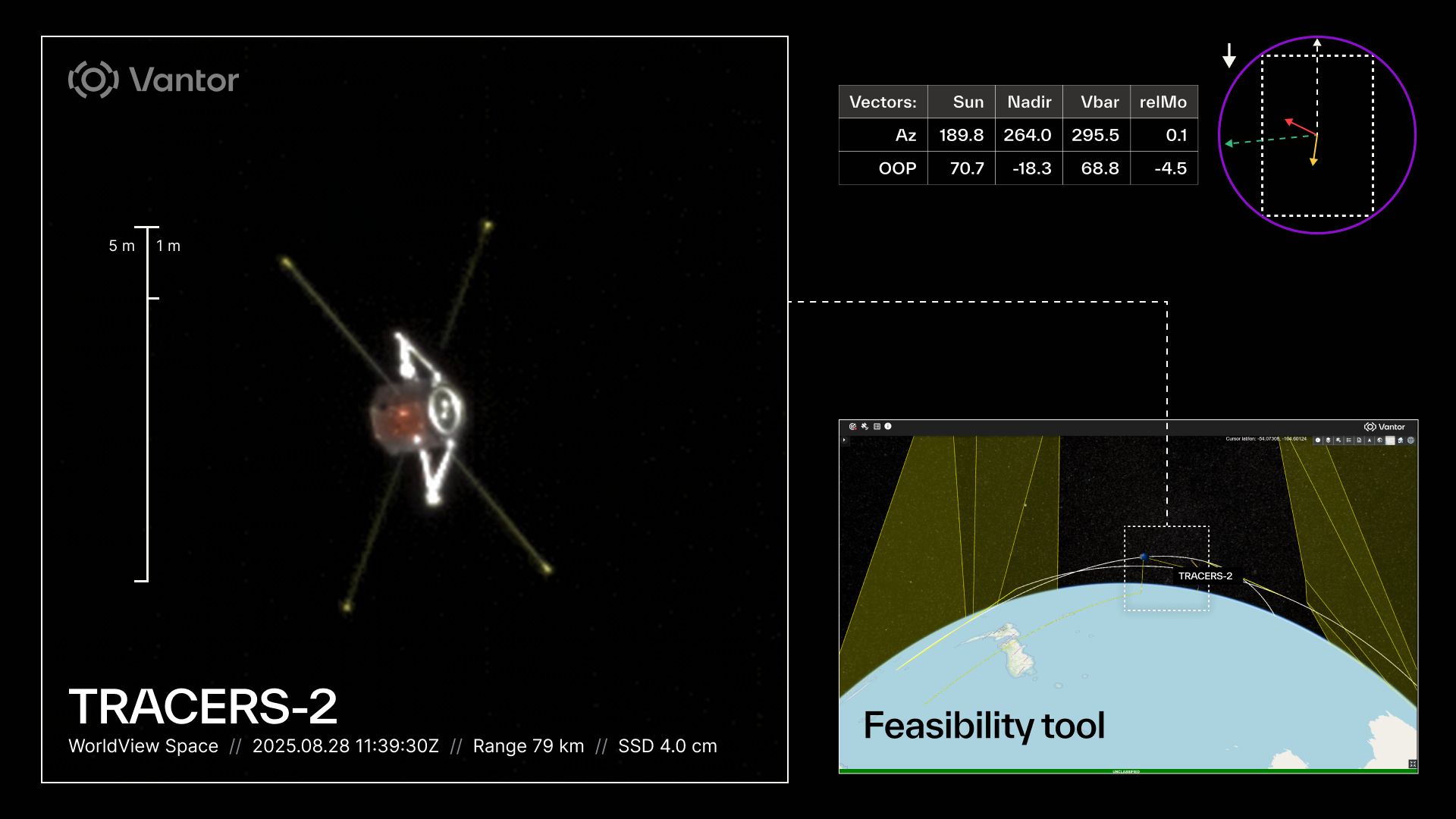
Left: A non‑Earth satellite view of TRACERS‑2, part of NASA’s mission to study interactions between solar energy and Earth’s magnetic field, captured in August 2025. Data on the spacecraft’s orientation and velocity provide insight into its behavior. (Credit: Vantor)
22 October, 2025
Vantor has been awarded a U.S. Space Force contract to expand space domain awareness through continuous tracking of “high‑interest objects” in orbit. The company will deploy a constellation of space‑to‑space satellites designed to monitor regions that ground‑based radars and telescopes cannot easily cover. These spacecraft are intended to address persistent “blind spots” in geostationary and cislunar space, where adversary satellites or debris can maneuver undetected.
According to the Space Force, the system will provide persistent, real‑time monitoring of satellites and other objects, enhancing early warning and collision avoidance. Vantor emphasizes that its architecture is scalable, allowing additional satellites to be added as operational needs evolve. While the program strengthens U.S. situational awareness, it also shows the growing militarization of near‑Earth space and the challenges of balancing security with transparency. This is another example of integrating commercial innovation into national defense strategies for orbital monitoring.
Apex Advances Golden Dome Vision With Self-Funded Space Weapons Demonstration of Orbital Interceptor Platform
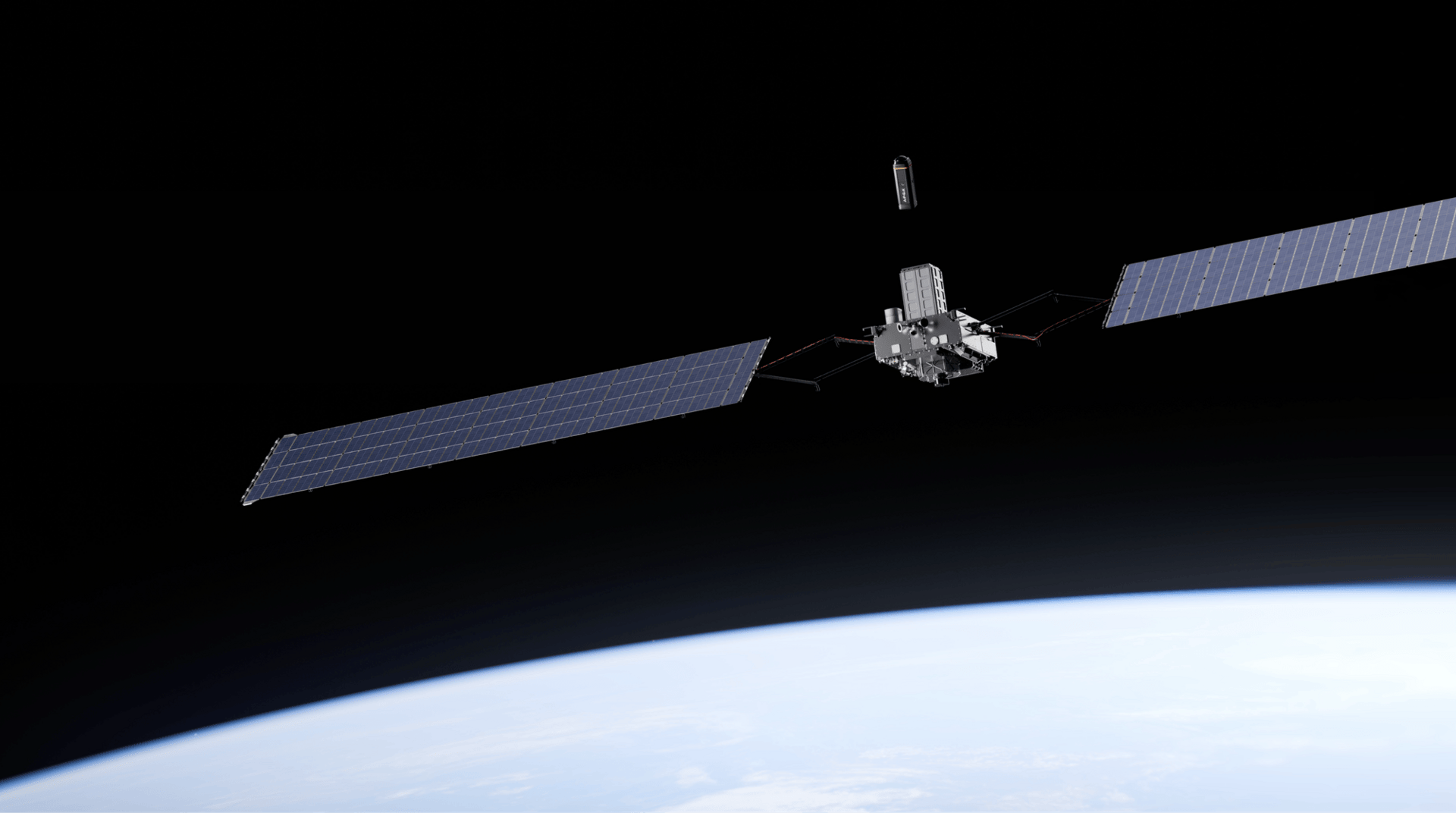
A rendering of Apex’s Nova satellite bus. (Credit: Apex)
22 October, 2025
California-based startup Apex has announced Project Shadow, a privately funded demonstration of space-based interceptor technology scheduled for launch in June 2026. The mission will test an “Orbital Magazine,” a satellite platform designed to host and deploy prototype missile interceptors. Unlike traditional procurement, Apex is investing $15 million of its own capital, positioning the effort as both a technology maturation exercise and a bid for future Pentagon contracts under the proposed Golden Dome missile defense initiative.
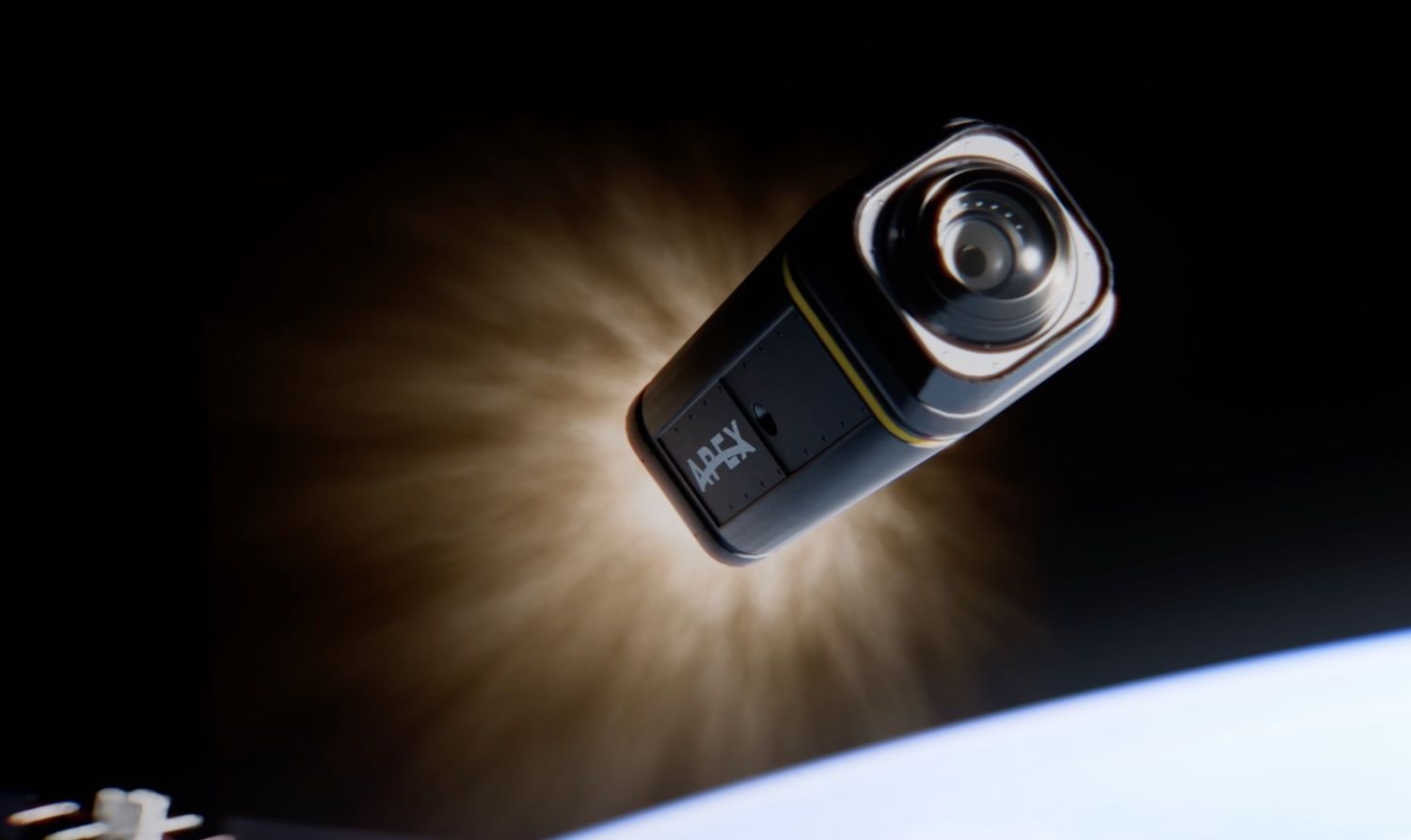
An artist’s illustration shows Apex’s space based interceptor fired from a satellite in low-Earth orbit. (Credit: Apex)
The Orbital Magazine will validate key functions such as environmental control, power supply, and in-orbit communications for interceptors, though the demonstration will not involve live weapons. Apex argues that proving these enabling technologies could accelerate deployment timelines for a potential interceptor constellation, which analysts estimate could require thousands of units.
So while Apex avoids calling it weaponization and frames it as “maturation” or “proof of concept,” the technology being tested, space‑based interceptors, falls squarely within the category of space weapons, raising strategic and legal questions about escalation and the future of arms control in orbit.

COMMERCIAL
Starcloud Plans First Satellite Mission with NVIDIA H100 GPU to Test Orbital Data Centers, Real‑Time AI and Data Processing

This animation shows the company’s concept for a 5‑gigawatt space‑based data center powered and cooled by solar and radiator panels measuring roughly 4 km by 4 km. (Credit: Starcloud)
Starcloud, a Redmond, U.S.‑based orbital data-center startup, is preparing to launch its first satellite, Starcloud‑1, carrying an NVIDIA H100 GPU into orbit. The mission, scheduled for November aboard a SpaceX Falcon 9, will mark the first time a data‑center‑class GPU has operated in space. The 60‑kilogram satellite, roughly the size of a small refrigerator, is designed to test in‑orbit data processing, offering up to 100 times more computing power than previous spaceborne processors.
The company’s long‑term vision is to build orbital data centers powered by vast solar arrays and cooled by the vacuum of space, potentially reducing Earth’s reliance on energy‑intensive, water‑dependent terrestrial facilities. Starcloud projects that space‑based centers could cut energy costs tenfold and deliver significant carbon savings over their lifetimes.
Initial applications include real‑time analysis of Earth observation data, wildfire detection, and rapid distress‑signal response. The satellite will also run Google’s Gemma language model, demonstrating that advanced AI workloads can be performed directly in orbit.
China Expands Qianfan Constellation, Landspace Advances Reusable Launch Systems as Space Pioneer, Galactic Energy Move Toward IPOs
China’s commercial space sector is accelerating on multiple fronts, with renewed constellation launches, reusable rocket development, and expanding financial infrastructure.
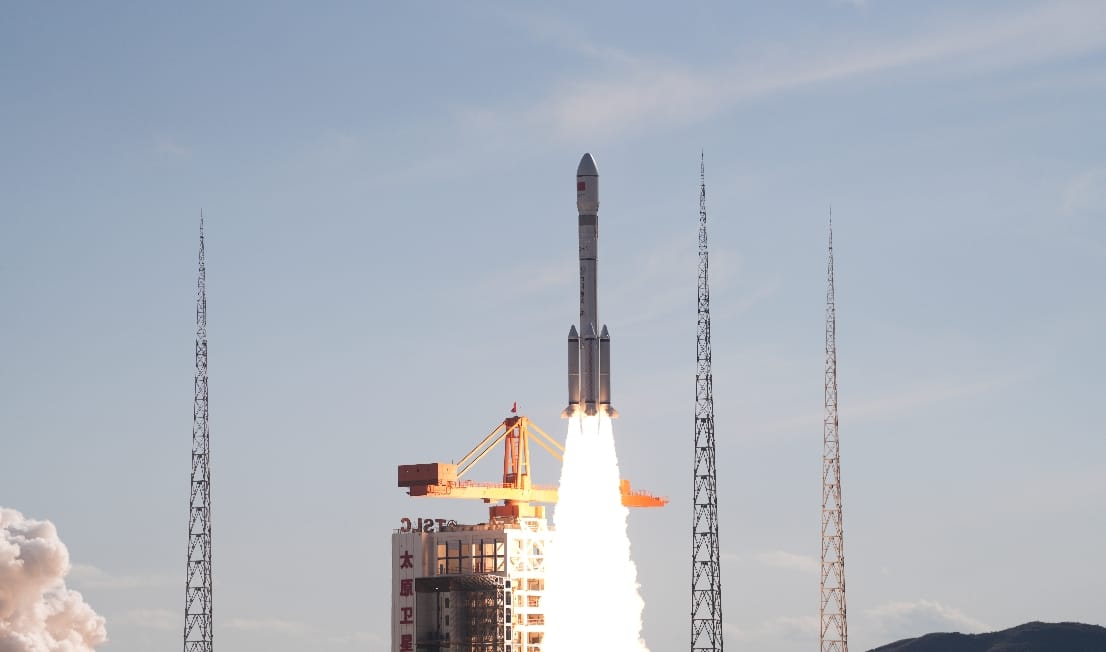
A Long March 6A rocket lifts off from the Taiyuan Satellite Launch Center in northern China, carrying 18 satellites for the Qianfan/Thousand Sails constellation, Oct. 17, 2025. (Credit: CASC)
19 October, 2025
After a months-long pause, the Shanghai-backed Qianfan (Thousand Sails) constellation resumed deployment with the launch of 18 satellites aboard a Long March 6A rocket from Taiyuan Satellite Launch Center in northern China. This brings the total to 108 satellites in orbit, part of a planned 15,000+ satellite network aimed at global broadband coverage. The project, led by Shanghai Yuanxin Satellite and backed by municipal and national institutions, is China’s answer to Starlink, with ambitions to serve underserved regions and expand digital influence abroad.
The launch also included international payloads, though client identities remain undisclosed. CAS Space, the commercial launcher involved, is positioning itself as a global service provider amid growing demand for non-geostationary satellite deployment.
This launch comes a day after China marked its 600th Long March launch with a Long March 6A rocket from Taiyuan, delivering satellites for the Guowang broadband constellation, a key part of the country’s national space infrastructure. GuoWang now has 95 satellites in space, part of a planned 13,000+ satellite network.
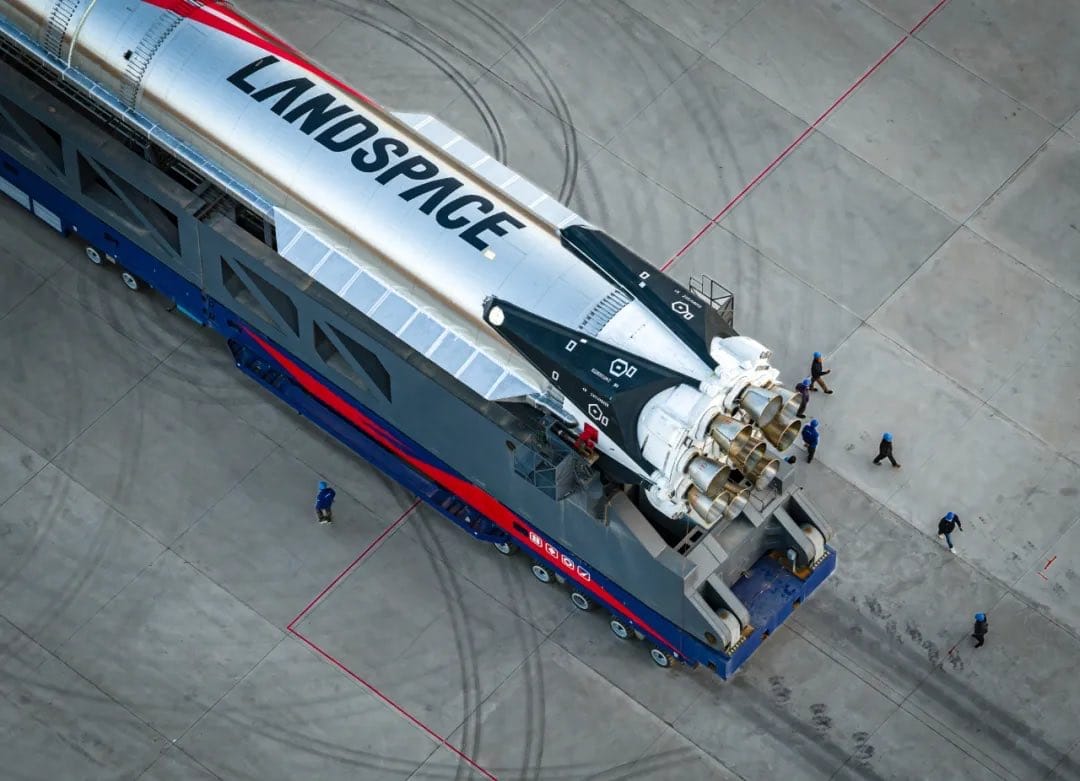
Landspace carried out a static-fire test of its stainless steel Zhuque-3 rocket on October 20, helping keep the vehicle on schedule for a planned debut launch before the end of 2025. (Credit: LandSpace)
20 October, 2025
Meanwhile, China’s private launch sector is advancing toward reusability as Landspace prepares its Zhuque-3 (ZQ-3) rocket for a debut flight. Landspace, one of China’s leading private launch firms, completed a static fire, at the company’s Huzhou facility, for its reusable Zhuque-3 rocket, designed to compete with SpaceX’s Falcon 9. Between October 18 and 20, 2025, Zhuque-3 completed its first major test campaign, including full propellant loading and a static fire at Dongfeng’s methane launch pad. The next steps include vertical integration rehearsal and technical inspections ahead of its planned orbital flight and first-stage recovery attempt.
The vehicle uses liquid methane and oxygen propulsion and is expected to debut in late 2025. Zhuque-3 features a stainless steel structure and grid fins for vertical landing, with plans for full recovery and reuse. Its development is a result of China’s growing interest in cost-effective launch solutions and increase cadence as domestic satellite constellation demand surges. Landspace is yet to conduct a full flight test.
20 October, 2025
Financing trends are also shifting; China’s commercial space sector is edging toward financial mainstreaming, with launch firms preparing IPOs and capital inflows continuing. Space Pioneer and Galactic Energy are among those seeking public listings, signaling a shift toward regulated growth. IPO filings by firms like CAS Space, 3D-printed rocket fairing company iStar Aerospace, satellite manufacturer MinoSpace and YeeSpace, suggest a maturing financial ecosystem, though exits remain rare. Commercial space investment in China reached ¥21 billion (~US$3 billion) in 2024. This year, launch companies alone have raised ¥8 billion (~US$1.1 billion), with 26 funding rounds. Provincial governments remain key backers, but institutional interest is growing. China’s space startups are evolving from venture-backed experiments into infrastructure-oriented firms with long-term strategic roles.
South Korea’s Innospace Secures Approval for First Commercial Orbital Launch from Brazil with International Payloads
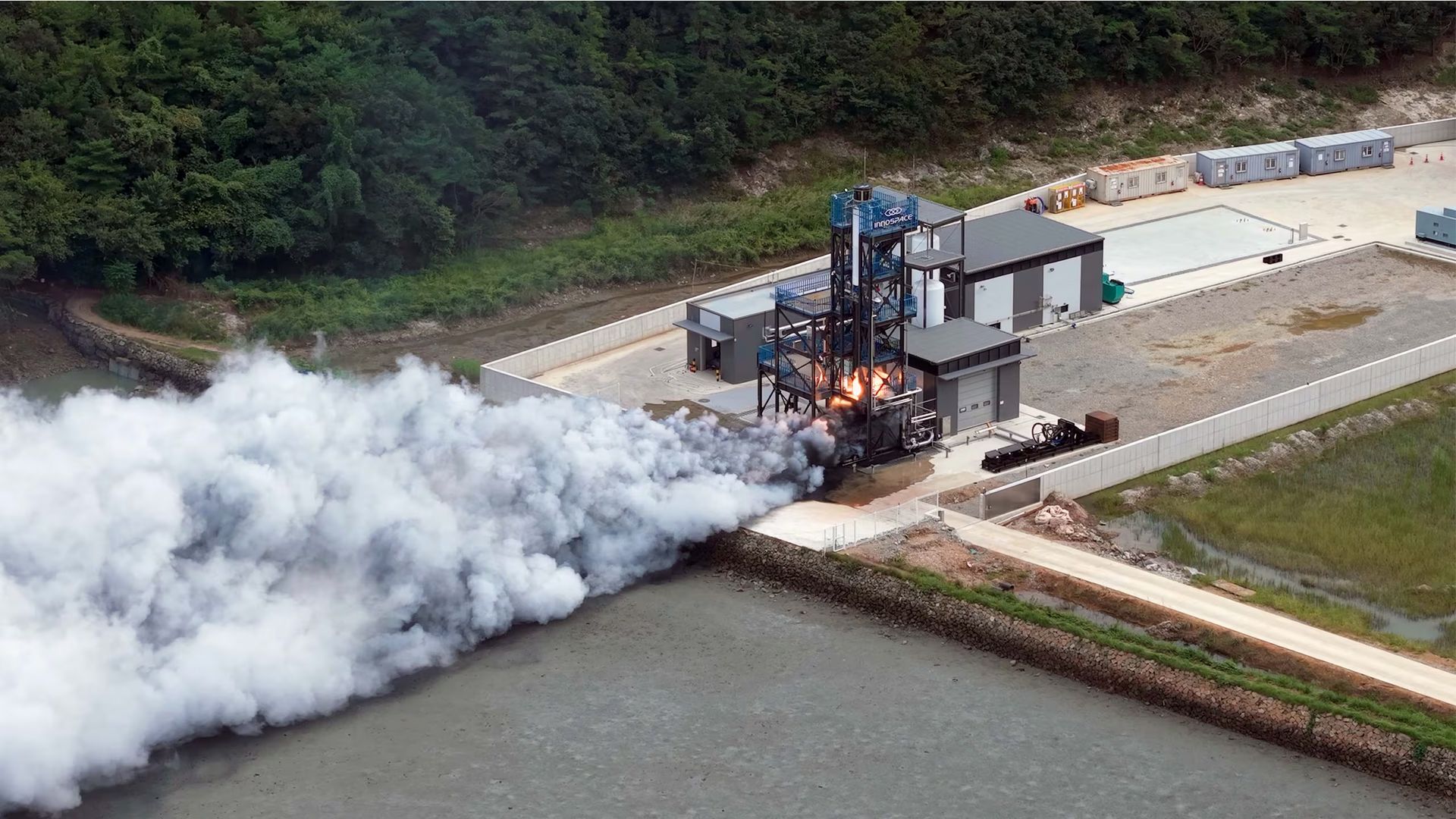
Innospace had successfully completed the first stage certification test of its first commercial launch vehicle, Hanbit-Nano, at its own testing facility, the Goheung Integrated Test Center, on 18 September 2025. (Credit: Innospace)
19 October, 2025
South Korea’s Innospace has received commercial launch authorization from the newly established Korea AeroSpace Administration (KASA) for its first orbital mission, Spaceward, marking a milestone for the country’s private space sector. The launch window for the Hanbit-Nano rocket spans October 28 to November 28 from Brazil’s Alcântara Space Center. The mission will carry eight registered payloads, including satellites and experimental units from clients in Brazil, India, and South Korea. To be deployed into low Earth orbit at 300 km, the payloads will include five small satellites for climate monitoring, tech development, and education, and three experimental units for in-orbit validation.
NASA Considers Reopening Artemis III Lunar Lander Contract Amid SpaceX Delays
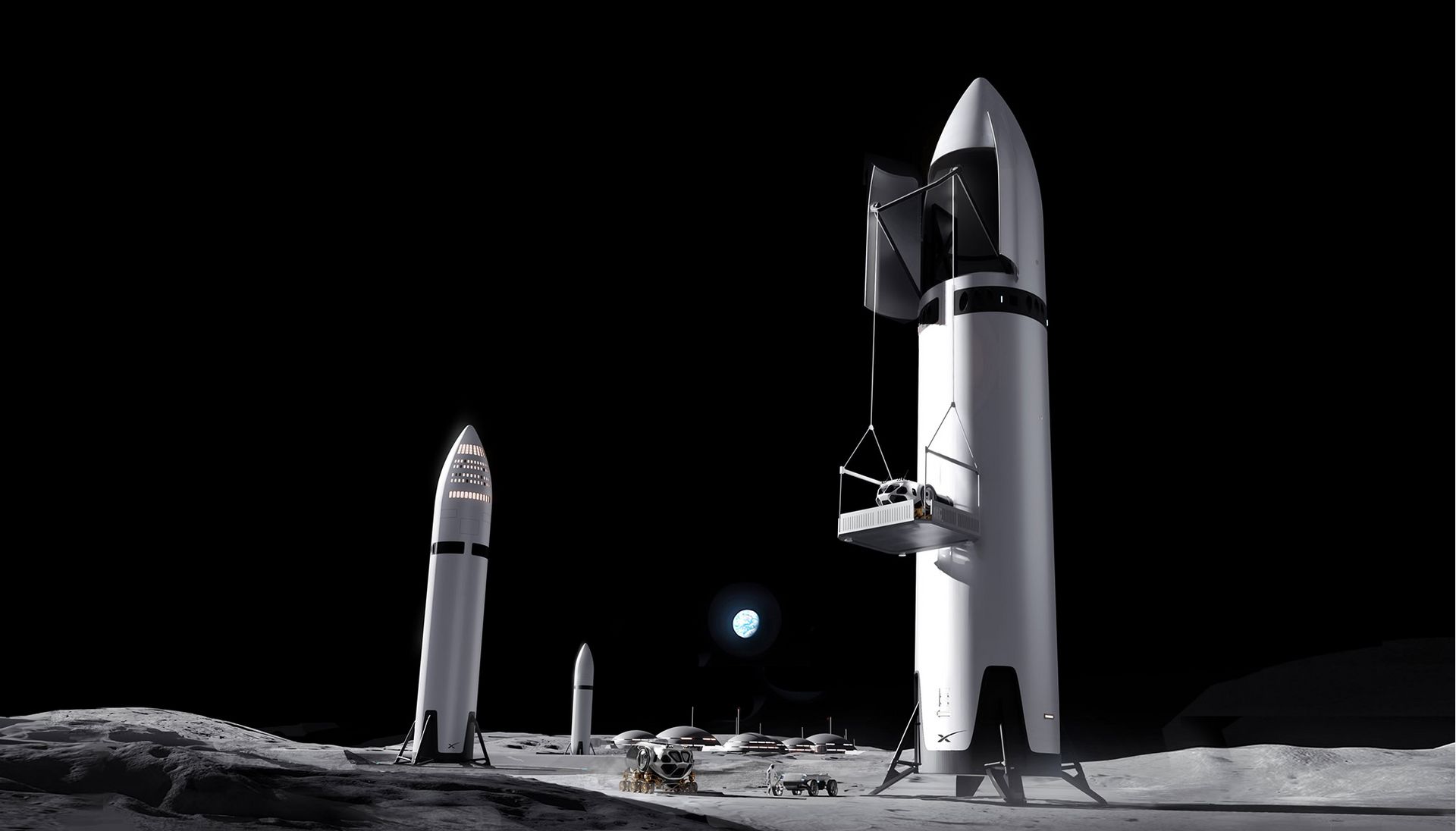
An artist's illustration of SpaceX's Starship on the moon with rovers and lunar infrastructure, during a NASA Artemis mission. (Credit: SpaceX)
20 October, 2025
NASA’s Artemis III program, intended to return U.S. astronauts to the lunar surface by 2027, is facing renewed uncertainty as acting administrator Sean Duffy signaled that SpaceX’s exclusive lander contract may be reopened to competition. Duffy cited delays in Starship’s development, including unproven in‑orbit refueling and safety testing, and argued that the U.S. cannot afford to fall behind China’s stated goal of a 2030 crewed landing. He suggested companies such as Blue Origin could be invited to accelerate alternatives, though experts caution that no competitor is likely to meet the current schedule.
Artemis III has faced repeated delays, driven not only by SpaceX’s still‑testing Starship but also by setbacks with spacesuits, NASA’s Orion capsule, and related systems. Originally slated for late 2024, the mission has slipped to 2025, then 2026, and is now projected for mid‑2027. Orion will ferry astronauts to lunar orbit, where they are expected to transfer to SpaceX’s Human Landing System, a $2.9 billion contract awarded in 2021 and based on a modified Starship upper stage, for the program’s first crewed lunar landing.
The remarks triggered a sharp response from Elon Musk, who dismissed the criticism and defended SpaceX’s pace, while also attacking Duffy personally on social media. The dispute comes amid broader debates over NASA’s leadership and structure, with proposals to fold the agency into the Department of Transportation drawing skepticism in Congress. This episode adds to the existing tensions between political urgency, technical readiness, and institutional stability.
Muon Space Adopts Starlink Optical Intersatellite Links for its Halo Satellite Platform to Enable Real‑Time Connectivity
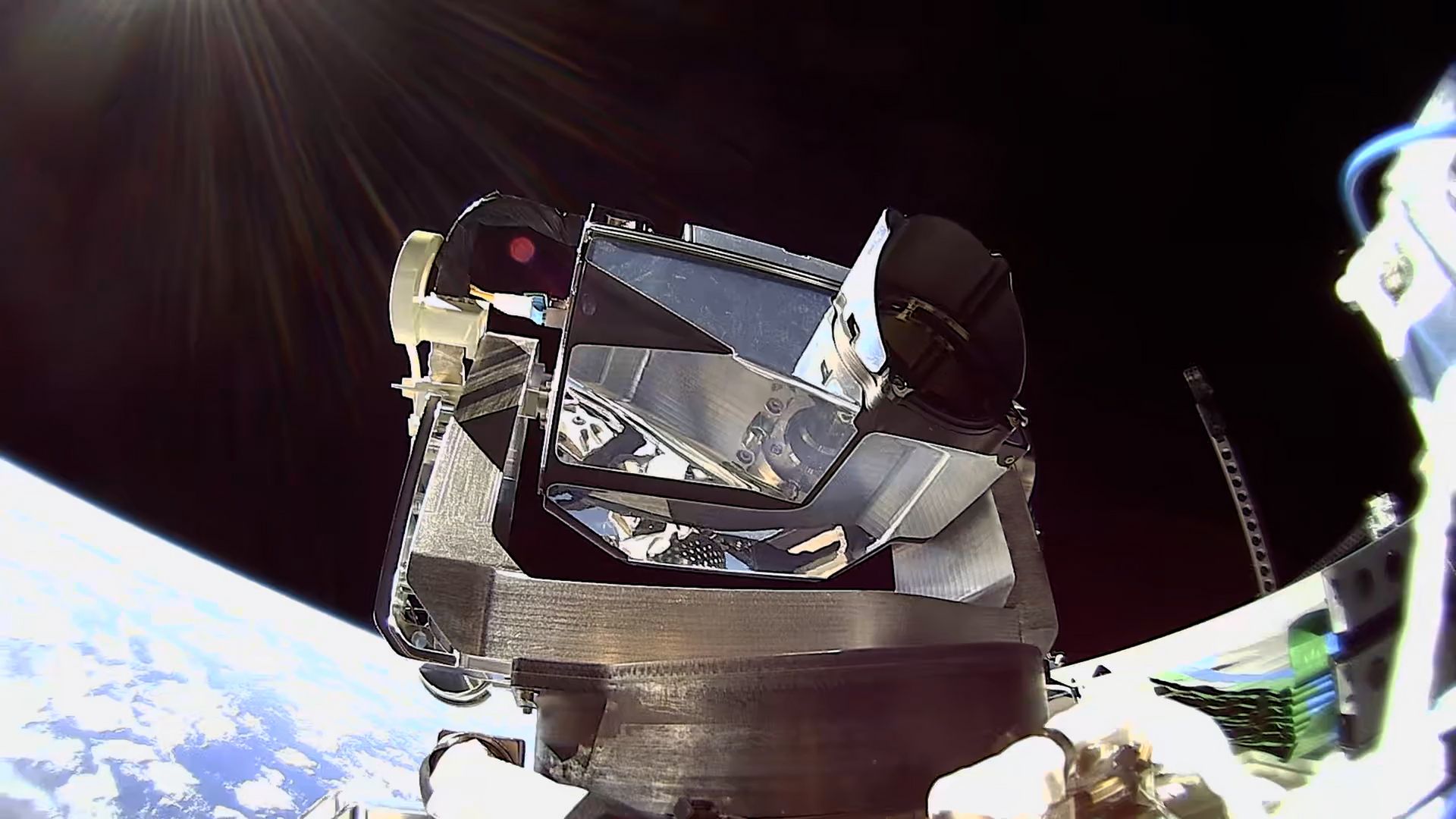
SpaceX reported that its mini laser terminal was successfully demonstrated in orbit on a satellite launched in August. (Credit: Starlink)
21 October, 2025
Climate-focused satellite intelligence provider, Muon Space announced it will integrate SpaceX’s “mini” Starlink laser terminals into its Halo satellite platform, marking one of the first commercial uses of Starlink’s inter‑satellite optical links outside SpaceX’s own constellation. The technology, originally developed to allow Starlink satellites to pass data directly between one another, enables up to 25 Gbps connections across distances of 4,000 kilometers. By embedding these terminals, Muon aims to transform its climate and weather monitoring satellites from isolated sensors into real‑time nodes on Starlink’s global mesh network. Muon expects to provide continuous, real‑time access to customer satellites and data in orbit, reducing reliance on ground networks and supporting instant tasking, payload control, and high‑bandwidth data delivery worldwide.
The first Halo satellite equipped with the system is slated for launch in early 2027, with integration already underway for customer spacecraft. SpaceX’s broader strategy has been to commercialize its laser technology by opening it to third‑party operators, a shift that could reshape how small satellite firms handle data relay. Other companies, including Vast with its planned Haven‑1 private station, have also shown interest in adopting the system.
Lynk and Omnispace Announce Merger as Airbus, Thales and Leonardo Form European Satellite Venture
Two major consolidation moves this week: satellite operators and aerospace giants are repositioning to compete in the fast‑growing direct‑to‑device (D2D) and broadband markets.
22 October, 2025
In the U.S., Lynk Global and Omnispace announced plans to merge, combining Lynk’s constellation of D2D and IoT‑enabled satellites with Omnispace’s valuable 60 MHz of globally coordinated S‑band spectrum rights. It represents the largest S‑band market access footprint, covering more than one billion people across the Americas, Europe, Africa, and Asia. The new entity, to be led by Lynk CEO Ramu Potarazu with Omnispace’s Ram Viswanathan as chief strategy officer, will target both commercial and government customers. SES, already an investor in both firms, will remain a key stakeholder. The merger is expected to close by early 2026 and is framed as a way to accelerate deployment of scalable, cost‑effective global connectivity. Analysts note that spectrum access is central to the deal, as competitors like SpaceX’s Starlink and AST SpaceMobile also race to secure high‑priority allocations.
23 October, 2025
Meanwhile in Europe, Airbus, Thales, and Leonardo signed a memorandum of understanding to combine satellite communications assets into a joint venture aimed at countering U.S. dominance through in low‑Earth orbit broadband. The companies argue that pooling resources is necessary to achieve scale and technological parity with Starlink, which has rapidly expanded its global footprint. The companies aim to create a sovereign alternative to Starlink and Amazon’s Kuiper, ensuring reduced reliance on non‑European and U.S. providers. Reuters and CNBC both noted that EU policymakers support this consolidation for competitiveness and resilience.
Under the code name "Project Bromo," discussions began last year. The newly formed company is set to launch in 2027, contingent on regulatory approval and logistical arrangements. Airbus will own 35% of the venture, while Thales and Leonardo will each hold a 32.5% stake.
National and regional players are consolidating to secure spectrum, capital, and industrial capacity in a market increasingly defined by a handful of powerful incumbents. The outcome will shape not only commercial competition but also strategic autonomy in space communications.

RESEARCH SPOTLIGHT
Newly Discovered Super‑Earth, 20 Light Years Away, Emerges as Key Candidate in Search for Habitable Worlds
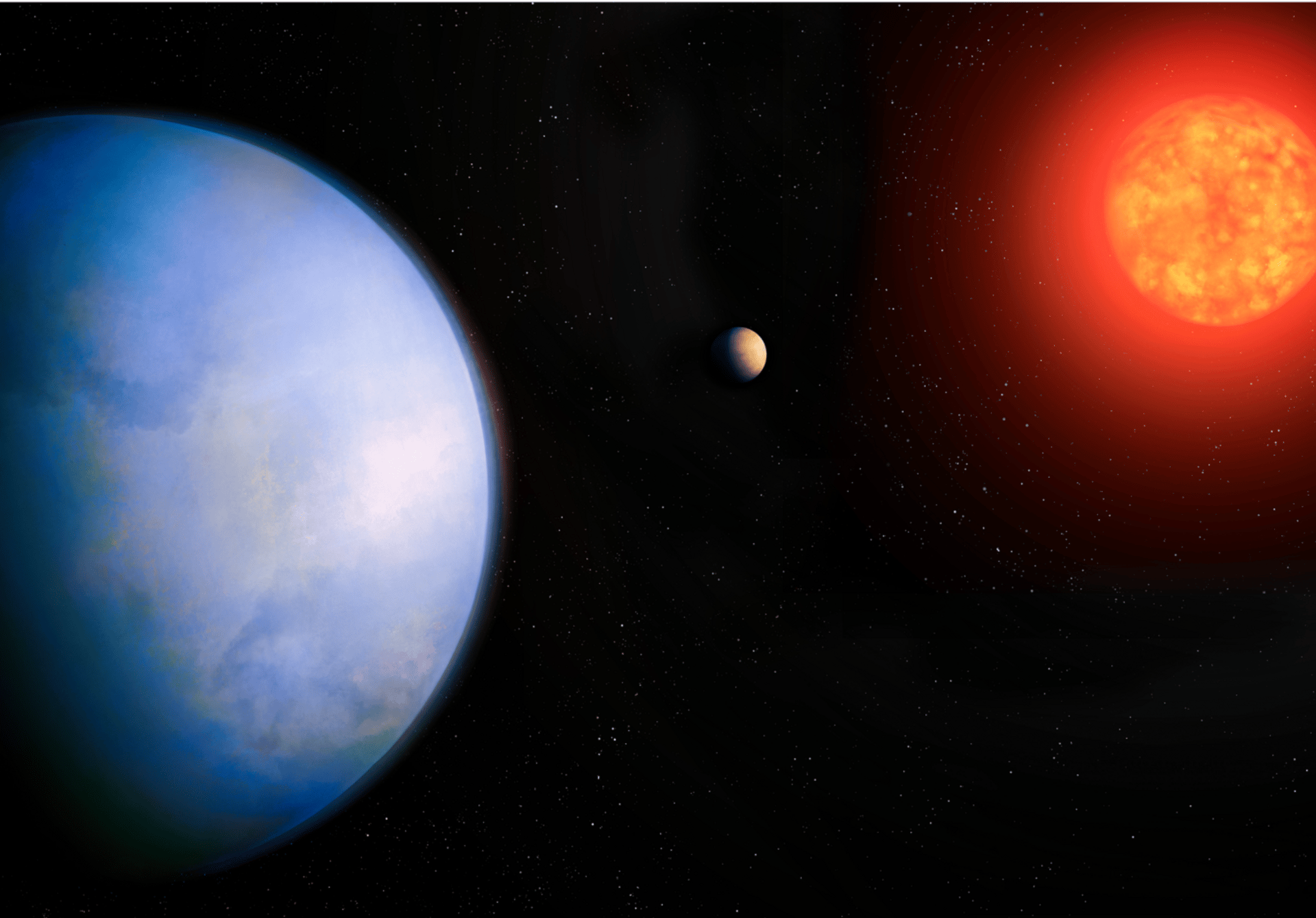
An international research team, including Penn State scientists, identified the exoplanet GJ 251 c as a “super‑Earth,” noting evidence of a rocky composition comparable to Earth but with nearly four times the mass. (Credit: Illustration by University of California Irvine)
Astronomers have identified a nearby “super‑Earth” as a promising candidate in the search for habitable worlds. The planet, designated Gliese 12 b, orbits a cool red dwarf star just 20 light‑years from Earth, in the constellation Pisces. Roughly the size of our planet but slightly larger, it lies within the star’s habitable zone or the ‘Goldilocks Zone,’ where temperatures may allow liquid water to exist. Researchers from Penn State and international collaborators used NASA’s TESS mission and ground‑based follow‑up to confirm the discovery.
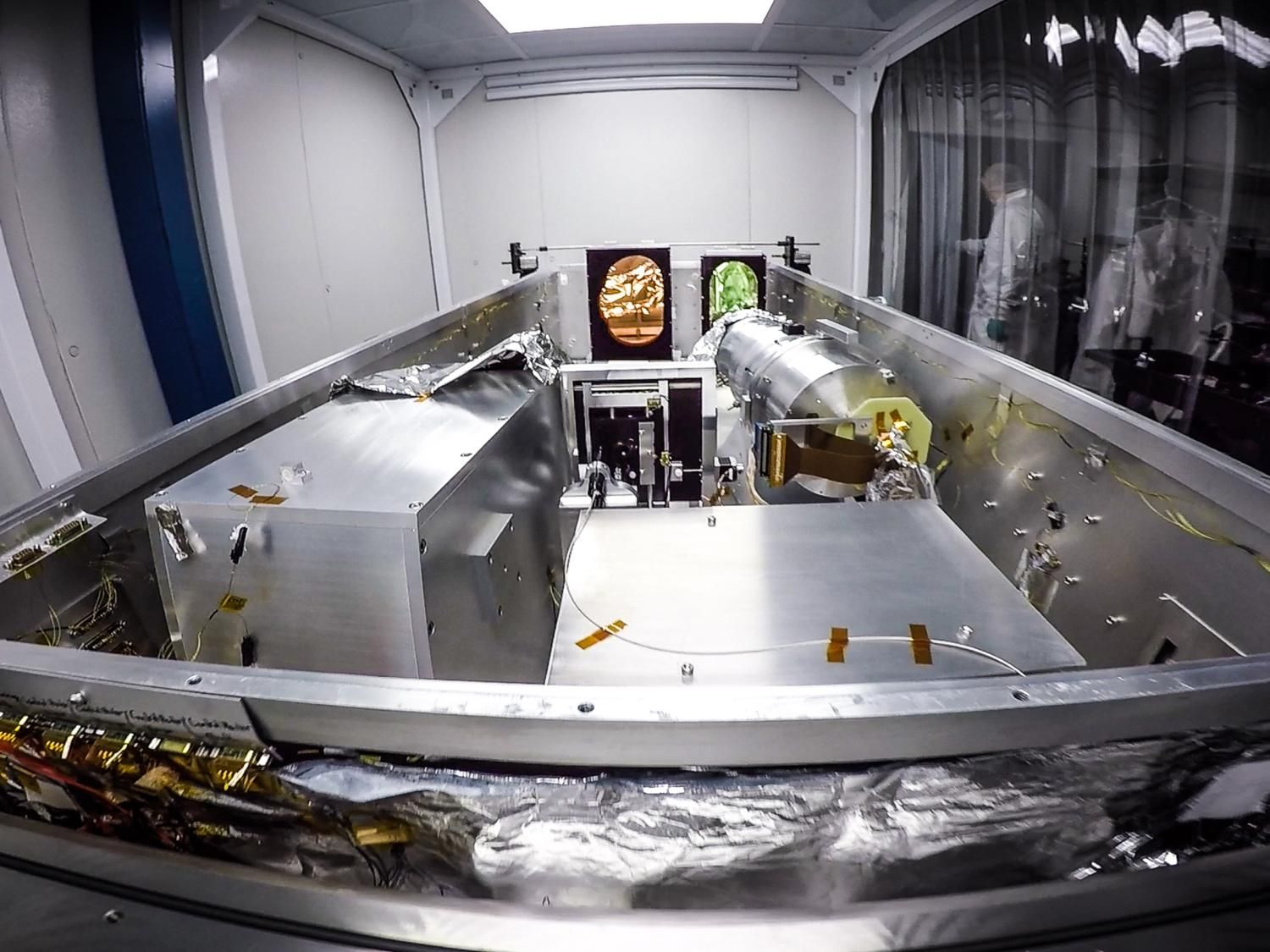
The Habitable Zone Planet Finder (HPF), developed under Penn State leadership, delivers the most precise infrared measurements yet of signals from nearby stars. Shown here is the HPF instrument being installed inside its clean-room housing on the Hobby Eberly Telescope at McDonald Observatory. (Credit: Guðmundur Stefánssonn / Penn State)
Researchers first refined measurements of the previously known inner planet GJ 251 b, which orbits its star every 14 days, using baseline observations to sharpen its detected “wobble.” When these data were combined with new, high-precision readings from the Habitable Zone Planet Finder (HPF), they uncovered a second, more pronounced signal with a 54‑day period — evidence of another planet in the system, significantly larger than the first.
What makes Gliese 12 b especially significant is its proximity and brightness, which make it accessible for atmospheric studies with the James Webb Space Telescope. Scientists hope to determine whether the planet retains an atmosphere and, if so, whether it shows signs of greenhouse gases or potential biosignatures. While red dwarf systems can be volatile, stripping atmospheres with stellar flares, this discovery provides a rare opportunity to probe conditions on a nearby, potentially habitable world.
Study Reveals How Dense a Neutron Star Can Be Before Becoming a Black Hole
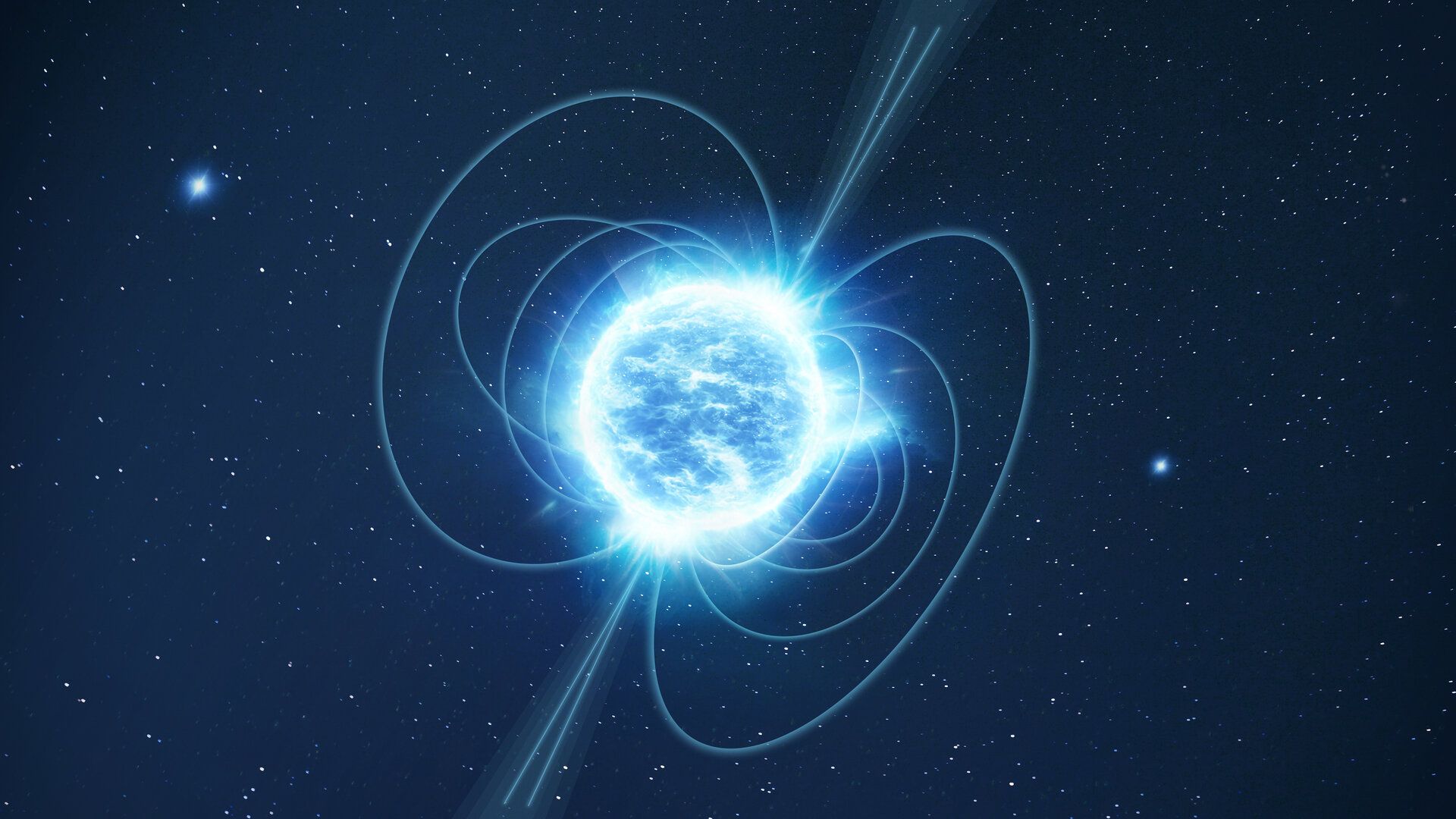
A neutron star forms when a massive star collapses after a supernova, compressing up to 2.5 solar masses into a sphere just 10–15 km wide—so dense that a sugar-cube-sized piece would outweigh Earth’s entire population. (Credit: ESA)
A new theoretical framework is helping astrophysicists understand and refine the boundary between neutron stars and black holes. Researchers have developed a relation that predicts how compact a neutron star can become before collapsing under its own gravity. Neutron stars, remnants of massive stars that exploded as supernovae, pack up to three solar masses into a sphere roughly 12 miles wide. Their extreme density makes them ideal laboratories for testing nuclear physics under conditions unattainable on Earth.
The study suggests that once a neutron star exceeds a certain compactness threshold, defined by mass and radius, it can no longer resist gravitational collapse and becomes a black hole. This work complements recent observations of neutron star collisions and the formation of low-mass black holes, offering a more precise tool for interpreting gravitational wave data and probing the limits of matter. It also informs models of stellar evolution and the fate of massive stars in binary systems. The research is published in the pre-print paper repository arXiv.
Researchers Discover Stable Molecular Structures on Titan That Defy Conventional Chemical Rules
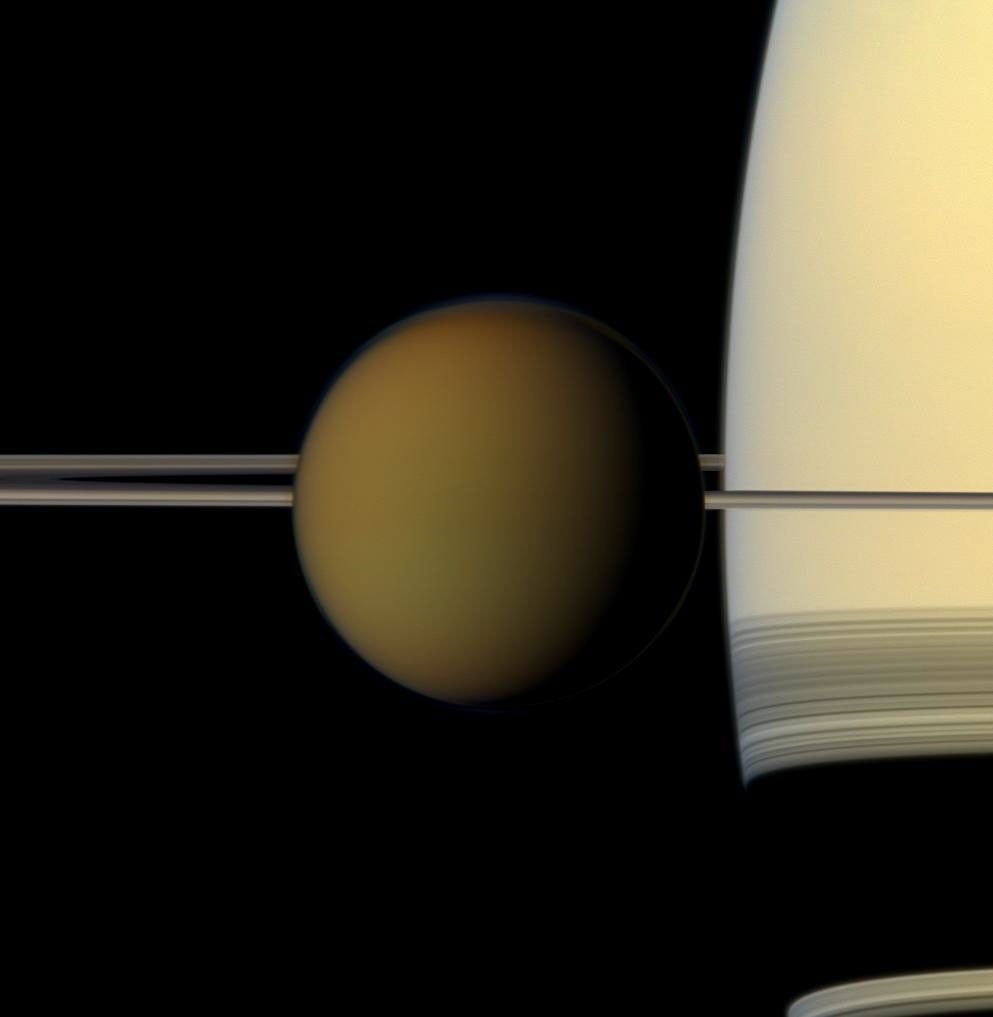
Titan passes in front of Saturn in this image from NASA's Cassini spacecraft. (Credit: NASA/JPL-Caltech/Space Science Institute)
A joint study by NASA and Chalmers University of Technology in Sweden has revealed that Saturn’s moon Titan hosts chemical interactions previously thought impossible. In Titan’s thick nitrogen and methane-filled atmosphere and ultra-cold environment, around minus 179°C, polar and nonpolar molecules, which typically repel each other, can combine to form stable crystalline structures. Specifically, hydrogen cyanide, a polar compound, was found to mix with nonpolar hydrocarbons like methane and ethane, defying the “like dissolves like” rule of chemistry.
These findings suggest Titan’s lakes and atmosphere may support complex prebiotic chemistry, offering insights into conditions that could precede life. The research, based on lab experiments and simulations, expands our understanding of chemical behavior in extreme environments and challenges assumptions rooted in Earth-based models. Titan’s resemblance to early Earth in terms of atmospheric composition and surface features makes it a compelling site for studying the origins of life, even if biological activity itself remains unlikely under current conditions. The study was published in the scientific journal PNAS.
Despatch Out. 👽🛸
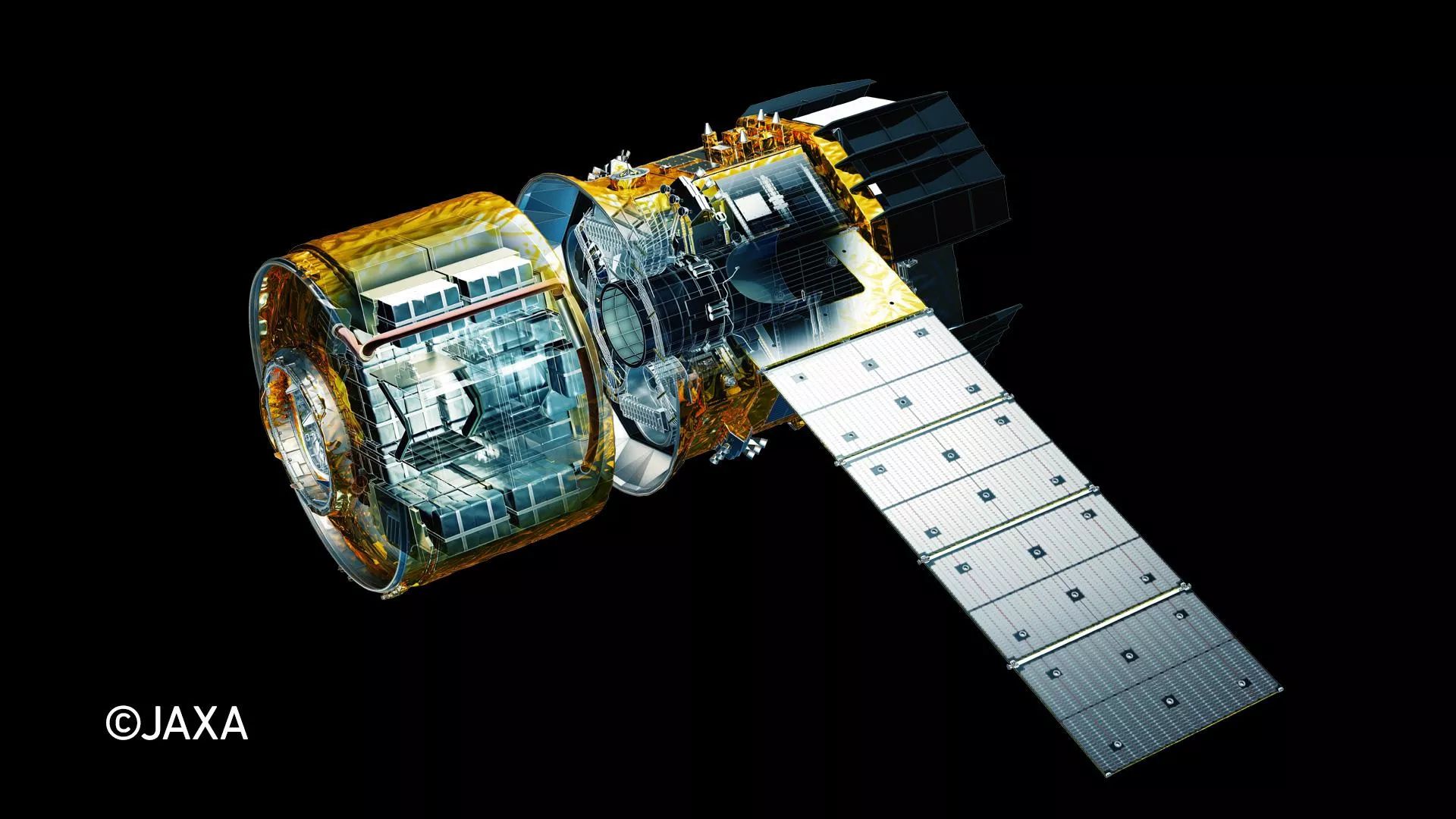
Reply